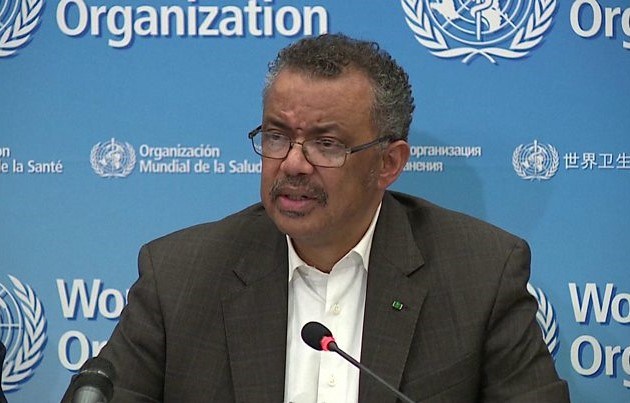Six months since WHO received the first reports of the outbreak of a disease of unknown cause in China the global number of confirmed cases of the coronavirus has reached 10 million and the death toll half a million.
At his virtual press conference on Monday (29 June) WHO Director- General, Dr Tedros Adhanom Ghebreyesus, warned that the coronavirus pandemic is far from over. “Six months ago, none of us could have imagined how our world – and our lives – would be thrown into turmoil by this new virus,” he said.
In fact, WHO has been warning the world about the danger from the very start of the outbreak. In the beginning the warnings were not specific and did not raise any alarm bells. When the world started to take the warnings seriously it was too late to contain the spread of the virus.
At the press conference, Dr Tedros announced that the WHO has started publishing an updated and detailed timeline of WHO’s response to the pandemic on its website, “so the public can have a look at what happened in the past six months in relation to the response.” WHO will update the timeline on a regular basis and in light of evolving events and new information.
The time line starts on 31 December 2019 when WHO’s Country Office in China picked up a media statement by the Wuhan Municipal Health Commission from their website on cases of “viral pneumonia” in Wuhan. The first cases in Europe were reported on 24 January 2020 when France informed WHO of three cases of the novel coronavirus, all of whom had travelled from Wuhan.
Other crucial dates are 11 March when WHO made the assessment that COVID-19 could be characterized as a pandemic. On 13 March, the WHO Director-General announced that Europe had become the epicentre of the pandemic with more reported cases and deaths than the rest of the world combined, apart from China.
The Brussels Times asked the WHO about the status of two evaluations of its response that have been decided by the World Health Assembly, the decision-making body of WHO, at its virtual meeting in May.
One resolution requested the WHO Director-General to initiate an “independent and comprehensive evaluation to review experience gained and lessons learned” from the WHO-coordinated response to COVID-19. In a second resolution, the Director-General was requested to “identify the zoonotic source of the virus and the route of introduction to the human population.”
As regards the first evaluation, it not clear if it is too early to launch such an evaluation and WHO did not clarify how and when it could start. In the meantime, WHO is stressing its own on-going internal review work, daily learning of lessons and data collection from its international networks.
At the press conference, Dr Tedros told The Brussels Times that the second evaluation is on its way and that WHO plans to send a team to China next week to prepare for the evaluation. “Knowing the source is very important. We hope that the evaluation will lead to an understanding of how the virus started and what we need to do in the future.”
Contact tracing
“The pandemic has brought out the best and the worst of humanity,” Dr Tedros said on Monday. “All over the world we have seen heart-warming acts of resilience, inventiveness, solidarity and kindness. But we have also seen concerning signs of stigma, misinformation and the politicization of the pandemic.”
“Some countries are now experiencing a resurgence of cases as they start to re-open their economies and societies. Most people remain susceptible. The virus still has a lot of room to move. We all want this to be over. We all want to get on with our lives. But the hard reality is: this is not even close to being over,” the WHO Director-General warned. “Globally the pandemic is actually speeding up.”
Asked about the best way to fight the pandemic, he replied that authoritarian leaders or “strongmen” cannot do it if the they think that they can take advantage of the crisis to suppress freedoms. “I have myself been a politician. At the end of the day, what you do must help your people. We need national unity across ideological divides and party lines.”
He was especially critical against the lack of sufficient contact tracing in many countries and rejected the “lame excuses” for not carrying out tracing. “If there is a single failure (in the handling of the crisis), it’s in contract tracing.”
He referred to Michael Ryan, the executive director of WHO’s Health Emergencies Programmes, who carried out contact tracing of Ebola in Congo (DRC), “wearing a bullet-proof helmet and jacket”. If he could do it in a war situation, risking his life, it should not be an issue in a more stable situation.
Asked by The Brussels Times about manual and digital tracing methods, Ryan replied that the primary success factor in contact tracing is a well-trained and well-organised human work force which is able of detecting every case, tracing all their contacts quickly and deciding on quarantine measures.
Digital tools are available now and Ryan admitted that they are helpful and should be applied. But he underlined, based on his experience in Congo, that the human driven process is key. “It’s not an automated process but about humans contacting humans, asking them questions and following up other human beings.
“Localised contact tracing would be my advice, enhanced by digital tools,” he summarized.
M. Apelblat
The Brussels Times

